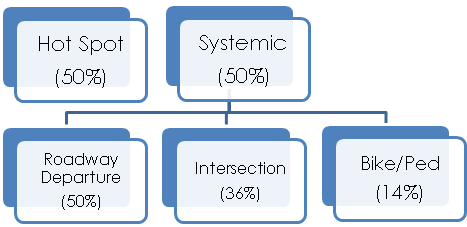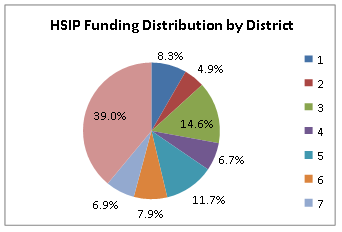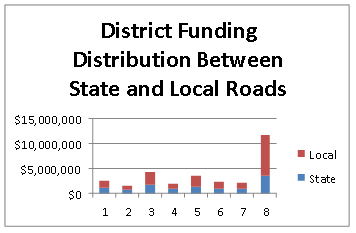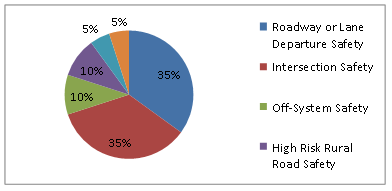U.S. Department of Transportation
Federal Highway Administration
1200 New Jersey Avenue, SE
Washington, DC 20590
202-366-4000
October 13, 2017
FHWA Office of Safety
The Highway Safety Improvement Program (HSIP) is a core Federal-aid highway program, the purpose of which is to achieve a significant reduction in fatalities and serious injuries on all public roads. The HSIP is a federally-funded, State-administered program under 23 U.S.C. 148, 23 U.S.C. 150, and 23 U.S.C. 130 and regulated by 23 CFR Parts 924 and 490. Under 23 CFR Part 490, each State is required to establish annual safety performance targets for five measures: 1) number of fatalities, 2) number of serious injuries, 3) fatality rate (per hundred million vehicle miles traveled (HMVMT)), 4) serious injury rate (per HMVMT), and 5) number of non-motorized fatalities and serious injuries.
If the State does not meet or make significant progress towards meeting its annual safety performance targets, the State must comply with the provisions set forth in 23 U.S.C. 148(i) for the subsequent fiscal year. The State must: 1) use obligation authority equal to the HSIP apportionment for the year prior to the year for which the targets were not met or significant progress was not made, only for HSIP projects; and 2) submit an annual HSIP Implementation Plan that describes actions the State will take to meet or make significant progress toward meeting its subsequent targets. Under 23 U.S.C. 148(i), the HSIP Implementation Plan must:
While the HSIP Implementation Plan has specific requirements as listed above, the State also must meet all HSIP planning requirements [23 U.S.C. 148(c)(2)(B) & (E) and 23 CFR Part 924.9] and consider those requirements as part of its HSIP Implementation Plan development efforts.
The purpose of this guidance is to clarify the HSIP Implementation Plan requirements presented in 23 U.S.C. 148(i). Specifically, this guidance addresses the HSIP Implementation Plan: 1) Schedule and Frequency, 2) Decision Support Framework, and 3) Content and Structure. States will meet the first two requirements of the HSIP Implementation Plan through the application of the decision support framework and HSIP planning process. The outcomes of these efforts will lead to the projects, strategies, and activities to be implemented, which will be included as part of the HSIP Implementation Plan.
In accordance with 23 CFR Part 490.211(e), FHWA will first evaluate whether a State DOT has met or made significant progress toward meeting its safety performance targets at the end of 2019. As described in the preamble to the Safety Performance Management Final Rule,[1] FHWA expects to report the results to the States no later than March 31, 2020. Additional information about the significant progress assessment can be found on the Met or Made Significant Progress Determination Fact Sheet.[2] If a State did not meet or make significant progress towards meeting its 2014-2018 safety performance targets, the State should submit an HSIP implementation plan for Federal Fiscal Year (FFY) 2021 to the FHWA Division Office by June 30, 2020. The FHWA Division Office should review the implementation plan to ensure it meets the applicable statutory and regulatory requirements and transmit the final HSIP Implementation Plan to the FHWA Office of Safety before October 1, 2020 (i.e., the start of the new fiscal year). The State must submit an implementation plan each year that it does not meet or make significant progress towards meeting its annual safety performance targets. 23 U.S.C. 148(i)(2).
The first step to developing an HSIP Implementation Plan is to understand why the State failed to meet or make significant progress towards meeting the State's safety performance targets. The decision support framework presented below mirrors some of the evaluation techniques in the HSIP Assessment Toolbox[3] and the Strategic Highway Safety Plan (SHSP) Evaluation Process Model.[4] As part of the decision support framework, the State should review fatality and serious injury trends, HSIP expenditures, and historical project performance. As part of this review, the State may identify gaps or deficiencies that can be improved through program modifications. States can review documented noteworthy practices and engage safety stakeholders in a discussion about program needs and potential solutions. As States conduct this analysis and outreach, they should consider how their findings might shape the State HSIP Implementation Plan (i.e., what changes in the State's program are necessary to address these deficiencies), as well as other State safety plans. As such, it may be helpful for the State DOT to work through this decision support framework in partnership with the State Highway Safety Office.
The State should review fatality and serious injury trends to better understand its highway safety needs. States should disaggregate fatality and serious injury trends in various ways. For example, the State might review data by region, district, or county as compared to the statewide trends. The State may also review fatality and serious injury trends by SHSP emphasis areas, rural/urban designation, functional classification, or roadway ownership to further isolate the problem. Some of this information may be available in the State's annual HSIP report.
The State should review historical HSIP obligations using the same disaggregation categories for comparison with the fatality and serious injury trends. Do the State's HSIP expenditures align with where the problems are occurring? For example, the SHSP is intended to drive HSIP investment decisions. Does the proportion of HSIP expenditures by SHSP
emphasis area align with the proportion of fatalities and serious injuries in those emphasis areas? The same type of comparisons can be made for expenditures on the state owned system and non-state owned system, rural and urban system, functional classification, etc. The Systemic Safety Project Selection Tool[5] provides further guidance on reviewing past funding practices.
As part of the State's HSIP evaluation process, the State should review the effectiveness of previously implemented projects, countermeasures, and programs to determine what is working and what may need further consideration. Other considerations may include:
For example, a particular countermeasure may address a target crash type under some conditions but not others. Perhaps there are other countermeasures better suited to those conditions. Alternatively, implementation of successful programs and treatments implemented as part of the HSIP should continue and be expanded if necessary. The HSIP Manual[6] and Systemic Safety Project Selection Tool provide further details on various evaluation approaches.
After a State reviews the above data and information, the State may identify gaps and deficiencies in the HSIP. The State should make program modifications to ensure the projects are identified, prioritized and programmed properly, and have the best potential for reducing fatalities and serious injuries. Such modifications may require the State to process Statewide
Transportation Improvement Program (STIP) amendments in order to add or modify HSIP projects in their existing program of projects.
A State may want to review literature on noteworthy practices that address State-specific crash characteristics. To achieve future performance targets, a State may want to identify noteworthy practices that it has not yet implemented and consider them in its HSIP. The FHWA's Roadway Safety Noteworthy Practices Database[7] and other similar resources (e.g., scan tour and peer exchange reports) may be a good starting point.
The State should also consider engaging safety stakeholders in a discussion about program needs and potential solutions. This outreach might include other offices within the Department of Transportation, the State Highway Safety Office, regional planning organizations, and local agencies. The State may educate stakeholders on the outcome from the reviews above and brainstorm potential programs, strategies and activities to address the State's HSIP gaps and deficiencies.
The State can use the input from the gap analysis, literature review, and safety stakeholders as a starting point for development of the HSIP Implementation Plan. The State must meet the HSIP Implementation Plan requirements [23 U.S.C. 148(i)(2)], as well as address all HSIP planning requirements [23 U.S.C. 148(c)(2)(B) & (E) and 23 CFR Part 924.9] and consider those requirements as part of its HSIP Implementation Plan development efforts. As part of the HSIP planning process, States identify roadway features that constitute a hazard to road users, as well as highway safety improvement projects on the basis of crash experience, crash potential, or other data-supported means. The results of this analysis will lead to the individual projects that will be implemented under the State's various HSIP programs, strategies, and activities and included in the State's HSIP implementation plan.
The HSIP Implementation Plan documents the State's HSIP funding and project decisions for the upcoming fiscal year to meet or make significant progress toward meeting its safety performance targets in subsequent years. The HSIP Implementation Plan is an opportunity for a State to re-evaluate its HSIP investment decisions and identify gaps or deficiencies to ultimately ensure that projects identified, prioritized, and programmed in the State have the best potential for reducing serious injuries and fatalities. The HSIP Implementation Plan should indicate available funding for the plan period; present funding allocation goals; provide an overview of HSIP programs, strategies, and activities; include a project list; and describe a summary of actions the State will undertake to achieve safety performance targets in subsequent years, as described below.
Under 23 U.S.C. 148(i)(1), States that do not meet or make significant progress towards meeting their safety performance targets must obligate HSIP funds in the amount apportioned for the prior year only for HSIP projects. For example, a State must obligate an amount equal to its Federal Fiscal Year (FFY) 2017 HSIP apportionment in FFY 2021 if it does not meet or make significant progress towards its 2014-2018 safety performance targets. Therefore, the State's FFY 2021 HSIP Implementation Plan should describe how the State plans to obligate at least the amount equal to its FFY17 HSIP apportionment. Attachment 1 lists the State HSIP apportionments for FFY17.
The HSIP Implementation Plan must describe how HSIP funds will be allocated during the plan period. 23 U.S.C. 148(i)(2)(C). In determining these funding allocation goals, the State should consider funding needs by SHSP emphasis areas (e.g., roadway departure, intersections), roadway ownership (e.g., state vs. local roads), improvement type (e.g., spot vs. systemic safety improvements), and other relevant categories. Ideally, these funding goals would be data-driven and reflective of the State's safety needs. The Reliability of Safety Management Series: Systemic Safety Programs[8] presents a
methodology to allocate funding between spot and systemic safety improvement projects. The State should provide a diagram or similar information to supplement the HSIP funding allocation description. For example, State X may allocate HSIP funding between spot and systemic improvements, and then further distribute the systemic funding based on the percentage of fatalities and serious injuries in each infrastructure–related SHSP emphasis area, as shown in Figure 1.

Figure 1 State X HSIP Funding Allocation (Example)
As another example, State Y may first allocate HSIP funding to the districts or regions within a State based on the distribution of fatalities and serious injuries in each district or region, and then further distribute the funding by roadway ownership based on the number of fatalities and serious injuries occurring on State-owned vs. non-State owned roads, as shown in Figure 2.


Figure 2 State Y HSIP Funding Allocation (Example)
As a final example, State Z may allocate HSIP funding by SHSP emphasis area fatality and serious injury distributions (see Figure 3), and then have a number of programs, strategies, or activities to address each emphasis area.

Figure 3 State Z HSIP Funding Allocation (Example)
The State's HSIP Implementation Plan must identify a combination of programs, strategies, and activities to be funded under the HSIP that will (1) contribute to a reduction in fatalities and serious injuries [23 U.S.C. 148(b) & 150(b)(1)] and (2) help the State achieve or make significant progress towards achieving their safety performance targets in subsequent years [23 U.S.C. 148(i)(2)(D)]. For HSIP purposes, FHWA defines a program as a group of projects (not necessarily similar in type or location) implemented to achieve a common highway safety goal. For example, some States have one program that includes all projects resulting from the HSIP planning component. Other States have multiple sub-programs. An example of a sub-program may be a skid treatment program designed to reduce wet-weather-related crashes at different locations. Some States also refer to sub-programs as activities or initiatives.
The HSIP programs, strategies, and activities should be informed by the State's SHSP and research conducted as part of the HSIP implementation plan development process. They must address roadway features that constitute a hazard to road users, as well as highway safety improvement projects that were identified on the basis of crash experience, crash potential, or other data-supported means. 23 U.S.C. 148(i)(2)(A)–(B). For each program, strategy, or activity, the State should provide the following information in the HSIP Implementation Plan.
Purpose
The State should describe the purpose of this program, strategy, or activity (i.e., what problem does it address), and how it relates back to the State SHSP. All HSIP projects, strategies, and activities must be consistent with the SHSP. 23 U.S.C. 148(a)(4)(A).
Cost
The State should indicate the estimated cost for this program, strategy, or activity. This estimate may also include project cost limits by phase (e.g., project development and delivery), by district, etc.
Methodology and Implementation Plan
The State should briefly describe the methodology that was used to identify projects under this program, strategy, or activity. This methodology should include a description of the data-driven process, including the target crash
type and facility type, as appropriate. States should consider using more advanced safety analysis methods to ensure reliability of data analysis results. See the Reliability in Safety Management Methods: Network Screening[9]for more information. The State should also describe the types of countermeasures or improvements that will be implemented as part of these projects, as well as an implementation schedule.
Benefits
The State must identify how the program, strategy, or activity will contribute to a reduction in fatalities and serious injuries and help the State make progress toward achieving the safety performance targets in subsequent years [23 U.S.C. 148(b)(c) & (i)(2)(D)]. The State should present quantitative evidence to the maximum extent possible, or a very strong qualitative justification for the program, strategy, or activity where quantitative evidence is not available.
A detailed list of projects that will be obligated during the subject fiscal year should be provided as an attachment or appendix to the HSIP Implementation Plan. While the HSIP Implementation Plan includes a project list, individual projects may still need to be justified and approved on a case-by-case basis in accordance with the stewardship and oversight agreement between the State and FHWA Division Office. In some cases, it may be appropriate for the State to list a systemic project without providing information about specific locations. At a minimum, the project list should include at least the following fields:
Project Name and Project Number are State defined fields.
Table 1 includes a project list template that the State may use or modify to meet best meet their needs.
Table 1 Project List Template
| Project Name | Project Number | Improvement Type | Project Cost | Program, Strategy or Activity | SHSP Emphasis Area | Functional Classification | Roadway Ownership |
|---|---|---|---|---|---|---|---|
| Project A | |||||||
| Project B | |||||||
| Project C | |||||||
| … |
In addition, the State should provide a table in the HSIP Implementation Plan summarizing the estimated number of projects and funding goals by program, strategy, or activity. Table 2 illustrates an example of a summary table.
Table 2 Example Summary Table
| Program, Strategy or Activity | Estimated # Projects | Estimated Funding |
|---|---|---|
| Program A | 5 | $5,000,000 |
| Strategy B | 12 | $1,200,000 |
| Activity C | 7 | $3,800,000 |
| Total | 24 | $10,000,000 |
The HSIP implementation plan must describe the actions the State will undertake to achieve or make significant progress towards achieving the State's safety performance targets in subsequent years. 23 U.S.C. 148(i)(2)(E). This description may include a summary of major program changes resulting from the effort to develop the HSIP Implementation Plan or actions necessary to accommodate the HSIP Implementation Plan. Since the projects, strategies, and activities included in the HSIP implementation plan must be consistent with the SHSP and STIP [23 U.S.C. 148(a)(4) & (10)], such actions might include SHSP updates or modifications to the STIP, recognizing that fiscal constraints and project schedules may impact programming to some degree.
| State | FY17 HSIP Apportionment[11] ($) |
|---|---|
| ALABAMA | 46,077,031 |
| ALASKA | 31,004,800 |
| ARIZONA | 43,159,446 |
| ARKANSAS | 30,490,529 |
| CALIFORNIA | 198,773,805 |
| COLORADO | 29,831,604 |
| CONNECTICUT | 29,537,309 |
| DELAWARE | 9,459,880 |
| DIST. OF COL. | 8,914,842 |
| FLORIDA | 118,157,887 |
| GEORGIA | 74,726,046 |
| HAWAII | 9,552,612 |
| IDAHO | 16,662,848 |
| ILLINOIS | 77,466,533 |
| INDIANA | 53,817,427 |
| IOWA | 27,175,922 |
| KANSAS | 18,750,605 |
| KENTUCKY | 40,499,117 |
| LOUISIANA | 42,651,957 |
| MAINE | 10,477,686 |
| MARYLAND | 34,408,151 |
| MASSACHUSETTS | 33,878,538 |
| MICHIGAN | 58,162,180 |
| MINNESOTA | 35,794,181 |
| MISSISSIPPI | 28,568,181 |
| MISSOURI | 56,964,289 |
| MONTANA | 24,882,649 |
| NEBRASKA | 15,214,311 |
| NEVADA | 21,129,531 |
| NEW HAMPSHIRE | 9,297,647 |
| NEW JERSEY | 56,178,737 |
| NEW MEXICO | 22,493,059 |
| NEW YORK | 93,628,551 |
| NORTH CAROLINA | 60,484,658 |
| NORTH DAKOTA | 12,218,799 |
| OHIO | 75,077,031 |
| OKLAHOMA | 36,895,867 |
| State | FY17 HSIP Apportionment[12] ($) |
|---|---|
| OREGON | 29,504,796 |
| PENNSYLVANIA | 97,043,015 |
| RHODE ISLAND | 12,926,288 |
| SOUTH CAROLINA | 40,226,379 |
| SOUTH DAKOTA | 15,685,762 |
| TENNESSEE | 49,871,364 |
| TEXAS | 220,003,552 |
| UTAH | 20,872,234 |
| VERMONT | 11,734,187 |
| VIRGINIA | 60,483,427 |
| WASHINGTON | 38,987,856 |
| WEST VIRGINIA | 26,755,867 |
| WISCONSIN | 43,226,412 |
| WYOMING | 15,506,962 |
[1] National Performance Management Measures; Highway Safety Improvement Program: Final Rule, 81 Fed. Reg. 13882, 13909 (March 15, 2016).
[2] FHWA, Met or Made Significant Progress Determination Fact Sheet, FHWA-SA-16-045, April 2016. https://safety.fhwa.dot.gov/hsip/spm/pm_progress_fs.cfm [3] FHWA, Highway Safety Improvement Program Assessment Toolbox, FHWA-SA-15-015, July 2015. https://safety.fhwa.dot.gov/hsip/resources/fhwasa15015/[4] FHWA, Strategic Highway Safety Plan Evaluation Process Model, FHWA-SA-12-035, March 2013. https://safety.fhwa.dot.gov/shsp/epm/
[5] FHWA, Systemic Safety Project Selection Tool, FHWA–SA-13-019, July 2013. https://safety.fhwa.dot.gov/systemic/fhwasa13019/
[6]FHWA, Highway Safety Improvement Program Manual, FHWA-SA-09-029, January 2010. https://safety.fhwa.dot.gov/hsip/resources/fhwasa09029/
[7] FHWA, Roadway Safety Noteworthy Practices, https://rspcb.safety.fhwa.dot.gov/noteworthy/default.aspx.
[8] FHWA, Reliability of Safety Management Series: Systemic Safety Programs, FHWA-SA-16-041, September 2016. https://safety.fhwa.dot.gov/rsdp/downloads/fhwasa16041.pdf
[9] FHWA, Reliability of Safety Management Methods: Network Screening, FHWA-SA-16-037, October 2016. https://safety.fhwa.dot.gov/rsdp/downloads/fhwasa16037.pdf
[10] https://safety.fhwa.dot.gov/legislationandpolicy/fast/hsip_reporting_guidance.cfm
[11] Source: FHWA Notice N 4510.812, Table 1. https://www.fhwa.dot.gov/legsregs/directives/notices/n4510812/n4510812_t1.cfm
[12] Source: FHWA Notice N 4510.812, Table 1. https://www.fhwa.dot.gov/legsregs/directives/notices/n4510812/n4510812_t1.cfm
